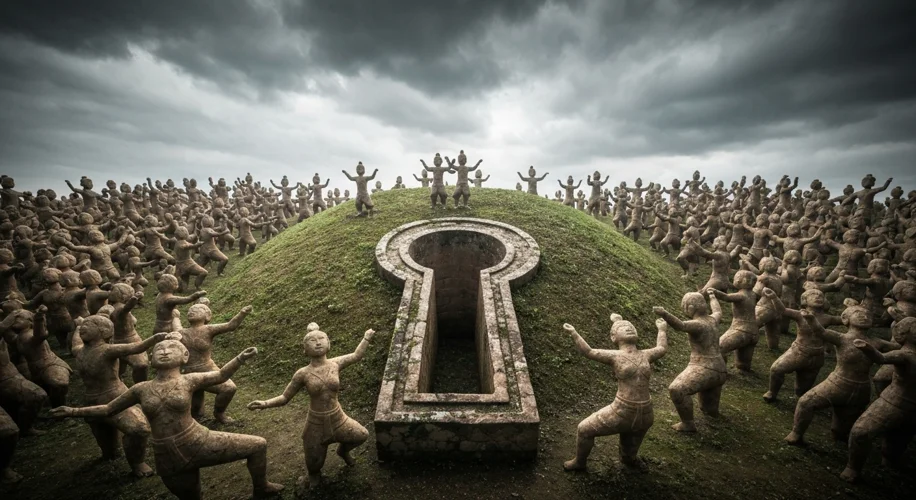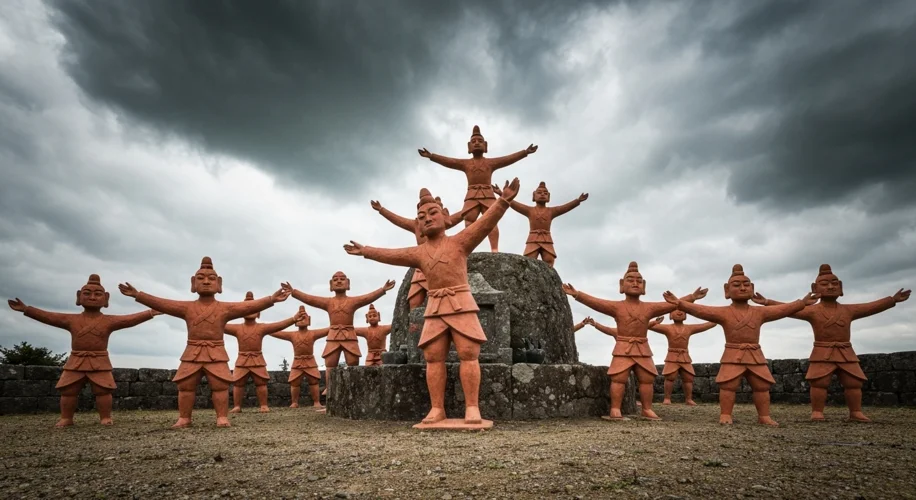Imagine a world shrouded in mist, where colossal burial mounds pierce the sky and the air hums with ancient rituals. This was Japan during the Kofun period, a time stretching from roughly 300 to 538 AD, a period so named for the massive, keyhole-shaped tombs – the kofun – that dot the landscape. Within these monumental resting places for the elite, a silent, enigmatic host of figures kept vigil: the Haniwa.
These terracotta sculptures, ranging from simple cylinders to elaborate representations of humans, animals, and objects, were more than just grave goods. They were crafted with a specific, spiritual purpose, believed to act as guardians and conduits for the souls of the departed. And among the most captivating of these are the Haniwa dancers, their forms frozen in motion, their purpose still a source of scholarly debate and public fascination.

The creation of Haniwa was a specialized craft. Potters, often working in dedicated villages, meticulously shaped clay on simple wheels or by hand, firing the figures in open bonfires. The process was labor-intensive, reflecting the importance placed on these funerary objects. Haniwa served a crucial role in the spiritual landscape of ancient Japan, acting as a symbolic barrier between the world of the living and the realm of the dead. They were placed on the slopes and surrounding areas of the kofun, forming a sacred precinct. Early Haniwa were often plain cylinders, but over time, they evolved into more figurative forms, mirroring the changing social and religious beliefs of the era.
The human figures, in particular, offer a unique window into the past. We see warriors in full armor, women in elegant robes, and men and women engaged in various daily activities. Among these, the Haniwa dancers stand out. Their stylized, often elongated forms, with arms outstretched as if in mid-pirouette or perhaps in a gesture of supplication or invocation, evoke a sense of mystical performance. Some are depicted with serene expressions, while others seem caught in a moment of intense energy.
What were these dancers commemorating or invoking? Scholars speculate that they might represent sacred rituals, shamanic ceremonies, or even performances held during funeral rites to entertain or appease the spirits of the deceased. The rhythmic, repetitive movements often associated with dance could have been seen as a way to connect with the spiritual world, to guide the soul’s journey, or to ensure prosperity for the living through divine favor.
The very materiality of Haniwa – their earthy, unglazed terracotta, their often-weathered appearance – imbues them with a haunting, ghostly quality. They are not merely statues; they are vessels, thought by some to contain the very essence or spirit of the deceased. This belief likely stemmed from animistic traditions, where spirits were thought to inhabit objects.
The decline of the Kofun period and the subsequent rise of Buddhism in Japan brought about changes in burial practices and beliefs. As Buddhist cremation rituals became more prevalent, the need for large, elaborate kofun and their associated Haniwa diminished. By the Asuka period (538–710 AD), Haniwa production had largely ceased.
Today, the Haniwa dancers remain potent symbols of a distant past. Unearthed from their ancient slumber, they continue to captivate us with their silent stories. They are tangible links to a society that invested deeply in the afterlife, seeking to bridge the gap between worlds through ritual and art. These terracotta figures, crafted from the very earth that entombed them, stand as silent witnesses to the enduring human quest to understand mortality and the mysteries that lie beyond.
Their enigmatic presence invites us to ponder the beliefs and practices of a civilization long gone, reminding us that history is not just a collection of facts, but a tapestry woven with the threads of human spirituality, ritual, and the eternal dance between life and death.

